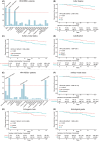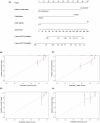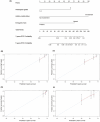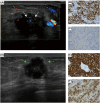Nomograms for predicting recurrence of HER2-positive breast cancer with different HR status based on ultrasound and clinicopathological characteristics
- PMID: 39248049
- PMCID: PMC11381954
- DOI: 10.1002/cam4.70146
Nomograms for predicting recurrence of HER2-positive breast cancer with different HR status based on ultrasound and clinicopathological characteristics
Abstract
Purpose: This study aimed to identify ultrasound and clinicopathological characteristics related to recurrence in HER2-positive (HER2+) breast cancer, and to develop nomograms for predicting recurrence.
Methods: In this dual-center study, we retrospectively enrolled 570 patients with HER2+ breast cancer. The ultrasound and clinicopathological characteristics of hormone receptor (HR)-/HER2+ patients and HR+/HER2+ patients were analyzed separately according to HR status. Eighty percent of the original samples from HR-/HER2+ and HR+/HER2+ patients were extracted by bootstrap sampling as the training cohorts, while the remaining 20% were used as the external validation cohorts. Informative characteristics were screened through univariate and multivariable Cox regression in the training cohorts and used to develop nomograms for predicting recurrence. The predictive accuracy was calculated using Harrell's C-index and calibration curves.
Results: Three informative characteristics (axillary nodal status, calcification, and Adler degree) were identified in HR-/HER2+ patients, and another three (histological grade, axillary nodal status, and echogenic halo) in HR+/HER2+ patients. Based on these, two separate nomograms were constructed to assess recurrence risk. In the training cohorts, the C-index was 0.740 (95% CI: 0.667-0.811) for HR-/HER2+ nomogram, and 0.749 (95% CI: 0.679-0.820) for HR+/HER2+ nomogram. In the validation cohorts, the C-index was 0.708 (95% CI: 0.540-0.877) for HR-/HER2+ group, and 0.705 (95% CI: 0.557-0.853) for HR+/HER2+ group. The calibration curves also indicated the excellent accuracy of the nomograms.
Conclusions: Ultrasound performance of HER2+ breast cancers with different HR status was significantly different. Nomograms integrating ultrasound and clinicopathological characteristics exhibited favorable performance and have the potential to serve as a reliable method for predicting recurrence in heterogeneous breast cancer.
Keywords: HER2; breast cancer; nomogram; recurrence‐free survival; ultrasound.
© 2024 The Author(s). Cancer Medicine published by John Wiley & Sons Ltd.
Conflict of interest statement
The authors declare that they have no competing interests.
Figures







Similar articles
-
Beyond CTS5 score: A novel nomogram predicting long-term prognosis in patients with hormone receptor-positive and human epidermal growth factor receptor 2-positive breast cancer.Curr Probl Cancer. 2025 Jun;56:101201. doi: 10.1016/j.currproblcancer.2025.101201. Epub 2025 Apr 3. Curr Probl Cancer. 2025. PMID: 40184873
-
Prognostic factors of patients with human epidermal growth factor receptor 2-positive breast cancer following neoadjuvant therapy: Development and validation of a predictive nomogram.Pathol Res Pract. 2024 Sep;261:155504. doi: 10.1016/j.prp.2024.155504. Epub 2024 Jul 31. Pathol Res Pract. 2024. PMID: 39116570
-
Validation of CTS5 Model in Large-scale Breast Cancer Population and Combination of CTS5 and Ki-67 Status to Develop a Novel Nomogram for Prognosis Prediction.Am J Clin Oncol. 2024 May 1;47(5):228-238. doi: 10.1097/COC.0000000000001080. Epub 2023 Dec 22. Am J Clin Oncol. 2024. PMID: 38131531
-
Development of a nomogram to predict recurrence scores obtained using Oncotype DX in Japanese patients with breast cancer.Breast Cancer. 2024 Nov;31(6):1018-1027. doi: 10.1007/s12282-024-01616-z. Epub 2024 Jul 17. Breast Cancer. 2024. PMID: 39020239 Free PMC article.
-
Discordance and clinical significance of ER, PR, and HER2 status between primary breast cancer and synchronous axillary lymph node metastasis.Med Oncol. 2014 Jan;31(1):798. doi: 10.1007/s12032-013-0798-y. Epub 2013 Dec 5. Med Oncol. 2014. PMID: 24307349 Review.
Cited by
-
Intratumoral and peritumoral ultrasound radiomics analysis for predicting HER2-low expression in HER2-negative breast cancer patients: a retrospective analysis of dual-central study.Discov Oncol. 2025 Jun 5;16(1):1007. doi: 10.1007/s12672-025-02752-4. Discov Oncol. 2025. PMID: 40471472 Free PMC article.
References
-
- Harbeck N, Penault‐Llorca F, Cortes J, et al. Breast cancer. Nat Rev Dis Prim. 2019;5:66. - PubMed
-
- Jelovac D, Wolff AC. The adjuvant treatment of HER2‐positive breast cancer. Curr Treat Options in Oncol. 2012;13:230‐239. - PubMed
-
- Perou CM, Sorlie T, Eisen MB, et al. Molecular portraits of human breast tumours. Nature. 2000;406:747‐752. - PubMed
-
- Arciero CA, Guo Y, Jiang R, et al. ER(+)/HER2(+) breast cancer has different metastatic patterns and better survival than ER(−)/HER2(+) breast cancer. Clin Breast Cancer. 2019;19:236‐245. - PubMed
-
- Cantini L, Pistelli M, Merloni F, et al. Body mass index and hormone receptor status influence recurrence risk in HER2‐positive early breast cancer patients. Clin Breast Cancer. 2020;20:e89‐e98. - PubMed
Publication types
MeSH terms
Substances
Grants and funding
LinkOut - more resources
Full Text Sources
Medical
Research Materials
Miscellaneous

